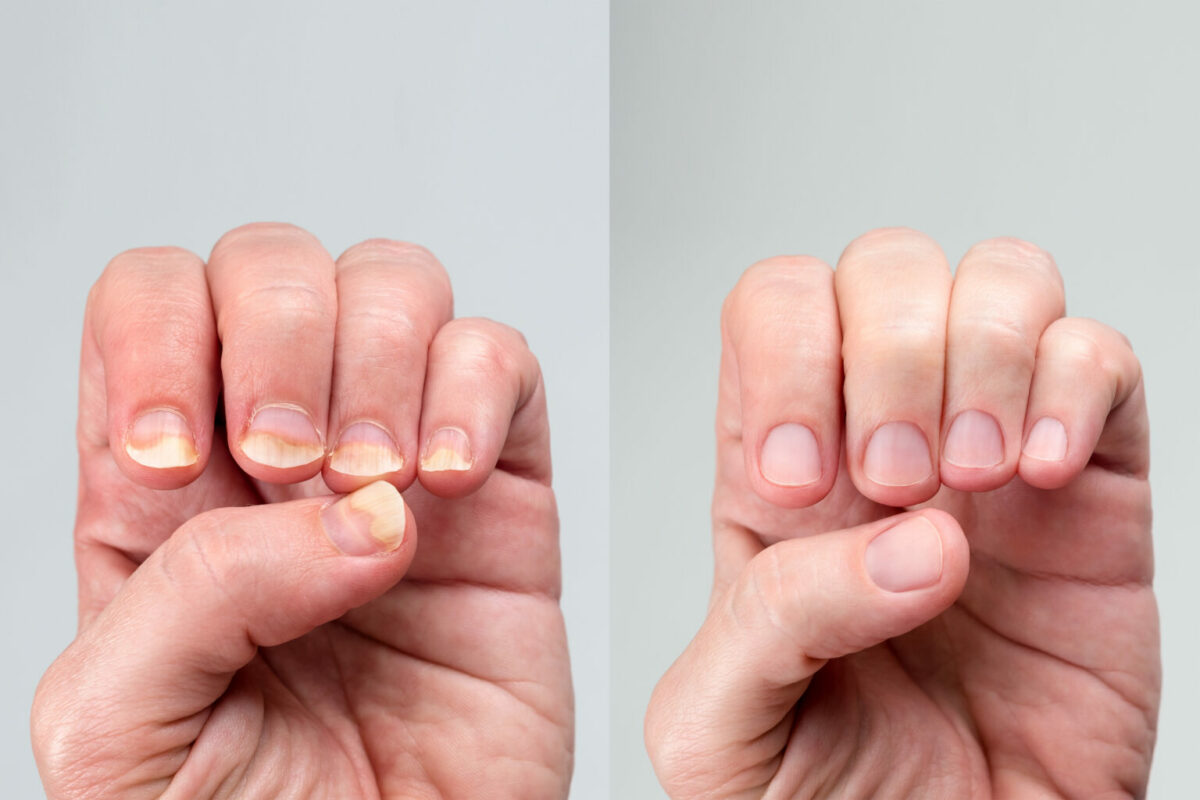No products in the cart.
Nail Care
Nail Fungus
Contents
- 1 Nail Fungus
- 2 Understanding Nail Fungus
- 3 Types of Nail Fungus
- 4 Symptoms and Clinical Presentation
- 5 Diagnoses of Nail Fungus
- 6 Treatment Options
- 7 Prevention Strategies
- 8 Living with Nail Fungus
- 9 Recent Research and Development in Nail Fungus
- 10 Conclusion
- 11 References from the National Library of Medicine
Nail Fungus
Onychomycosis, commonly called nail fungus, is a prevalent condition affecting millions worldwide. Therefore, it is crucial to comprehend the causes, nature, and treatments of nail fungus to maintain healthy nails and overall wellness.
Nail fungus occurs when fungi invade the nail, causing discoloration, thickening, and discomfort. Understanding nail fungus helps prevent it and ensures timely treatment to avoid complications.
Understanding Nail Fungus
Nail fungus is a condition that results from the excessive growth of fungi on, under, or around the nail. Typically, dermatophytes are the main culprits behind this infection, but yeasts and moulds can also be responsible for nail infections.
Several factors, such as aging, swimming in public pools, nail injury, or a weakened immune system, can contribute to nail fungus. A comprehensive understanding of nail anatomy can also help explain the occurrence of fungal infections and their resistance to treatment.
Types of Nail Fungus
There are multiple variations of nail fungus infections that individuals should be aware of. The most prevalent type, Distal Subungual Onychomycosis (DSO), impacts both the nail bed and the underside of the nail. White Superficial Onychomycosis (WSO) appears as white spots on the nail’s surface.
Candida Onychomycosis is a yeast infection affecting the nail and surrounding skin. It is more common in individuals who frequently immerse their hands in water. PSO, a less common type of onychomycosis, can concern those with weakened immune systems.
Symptoms and Clinical Presentation
Nail fungus can begin as a white or yellow spot beneath the nail’s tip. As the infection progresses, the nail may become discoloured, thickened, and develop jagged edges, an unappealing and potentially uncomfortable issue.
The fungus can result in severe complications, such as complete loss of the nail, and can also pose significant health risks for those with diabetes or immune disorders if left untreated. Identifying symptoms can improve treatment outcomes early.
Diagnoses of Nail Fungus
Healthcare professionals use a physical examination and lab testing to diagnose nail fungus and identify the type of fungus causing the infection.
Other conditions can present symptoms similar to nail fungus, such as psoriasis, contact dermatitis, and certain types of injury. Therefore, differential diagnoses are essential in verifying nail fungus infections.
Treatment Options
There are various over-the-counter treatments for nail fungus, like antifungal creams and ointments. In addition, healthcare professionals may prescribe oral antifungal drugs or medicated nail polish or cream in severe cases.
Surgical methods may be necessary for severe cases to eliminate the affected nail. Additionally, some individuals use home remedies and natural treatments, like tea tree oil and snakeroot extract, although further studies are required to verify their effectiveness.
Prevention Strategies
In managing nail fungus, prevention is vital. Maintaining short, clean, and dry nails can lower the likelihood of infection. Additionally, wearing moisture-wicking socks and utilizing antifungal sprays or powders may offer benefits.
Appropriate footwear in public areas such as gyms and swimming pools is crucial to prevent infection. However, people at a higher risk, such as older individuals, diabetics, and those with weakened immune systems, should exercise additional caution.
Living with Nail Fungus
Nail fungus can have a notable impact on a person’s life, causing discomfort and affecting self-esteem due to the appearance of the infected nail. However, with appropriate coping techniques, it can be managed effectively.
Individuals coping with nail fungus can access various support resources, including online and offline options. These resources offer practical tips, shared experiences, and emotional support to help alleviate the challenges associated with this condition.
Recent Research and Development in Nail Fungus
Ongoing studies and trials in nail fungus aim to develop more effective treatment methods. Laser treatment and novel antifungal drugs are promising therapies for managing this persistent condition.
Research on fungi causing nail infections and the body’s immune response aims to improve understanding and treatment options, potentially improving outcomes for nail fungus.
Conclusion
Knowing nail fungus, including its causes, symptoms, and treatments, is essential for maintaining healthy nails and improving quality of life. In addition, awareness of the condition can help prevent, identify, and treat it effectively, minimizing the risk of complications.
Advancements in the field of nail fungus offer hope for better treatments in the future. Therefore, it is essential for those impacted or susceptible to nail fungus to stay informed. By being knowledgeable, individuals can manage their health and maintain a comfortable lifestyle despite nail fungus.
References from the National Library of Medicine
Nail Fungus Overview
Recent advances in therapies for onychomycosis and its management
Onychomycosis: Pathogenesis, Diagnosis, and Management
Onychomycosis: An Updated Review

